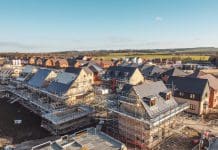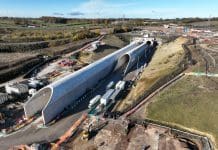Levels of new work in construction grew at the fastest pace since 2015 in February, while the boom in housebuilding allowed construction output to experience its sharpest rise since December 2018
UK construction companies signalled a return to business activity growth during February, following a nine-month period of declining workloads, according to the latest construction PMI.
The latest survey also pointed to the sharpest rise in new orders since December 2015.
At 52.6 in February, up from 48.4 in January, the IHS Markit/CIPS UK Construction Total Activity Index registered above the 50.0 no-change value for the first time since April 2019.
Additionally, the latest construction PMI signalled that the overall rate of construction output growth was the fastest for 14 months.
Survey respondents noted that improved demand had translated into higher levels of business activity in February, particularly in the housing and commercial sub-sectors. There were some reports, however, that severe weather conditions had led to delays on site and acted as a brake on growth.
Performance by construction category
Residential construction remained the best-performing category. Latest data signalled the strongest expansion of housebuilding activity since July 2018.
Commercial work also returned to growth in February, with the sub-sector posting its fastest increase in business activity since November 2018.
In contrast to the overall trend for construction output, civil engineering activity fell again during February. Though the rate of decline was only marginal and the least marked for 13 months.
New work
February data pointed to a strong recovery in new order intakes across the construction sector.
The increase in new work was the steepest recorded for just over four years. Survey respondents noted that greater tender opportunities and the release of spending that had been delayed in the run-up to Brexit. There were also reports citing a boost from increased infrastructure contract awards, including those related to HS2.
Higher levels of incoming new work helped to stabilise employment numbers across the construction sector in February. At the same time, demand for subcontractors increased for the second month running and to the greatest extent since December 2018.
Purchasing activity
Purchasing activity returned to growth in February, which reflected the trend seen for construction output levels. Stronger demand for inputs placed additional pressure on supply chains, with lead times lengthening to the greatest extent since last October. However, latest data indicated a slowdown in overall cost inflation since January.
Construction firms are upbeat about their growth prospects for the next 12 months. The degree of optimism eased since January but remained much stronger than seen in the second half of 2019.
Construction PMI resurgence
Duncan Brock, group director at the Chartered Institute of Procurement & Supply, commented: “After a sustained period of contraction in construction last year, the resurgence in levels of new work at the fastest rate since December 2015 was a surprising but much-needed development for a sector that was on its knees.
“As the blocks of December’s election and Brexit uncertainty were largely removed, it was the residential sector that was the main winner with the fastest escalation in housebuilding since July 2018.
“Purchasing levels rose at their fastest rate for over a year across the construction sector meaning unprepared suppliers bore the brunt of the upsurge. Their performance deteriorated again this month as delivery times and stocks of raw materials came under pressure.
“Should there be another sudden rise in purchasing activity in March, we are likely to see more challenges in supply chains, until suppliers have a chance to catch up. Given the slowdown in the global economy and potential coronavirus impacts, the sector could struggle to maintain February’s strong performance and may experience slower progress as we head into spring.”
Responding to the UK Construction PMI figures, Hannah Vickers, chief executive of the Association for Consultancy and Engineering (ACE), added: “After months of underwhelming news, these new figures will be welcomed by many as signs of a more positive outlook for the industry. However, difficulties remain and anecdotal evidence from many of our members is that much public sector work is slow to come to market.
“Looking ahead, a note of caution must now also be shared around the future outlook thanks to the delay to Heathrow’s expansion and legal action on HS2. Uncertainty on these major projects could, in a worst-case scenario, be compounded by a lasting negative macro-economic impact owing to the coronavirus.”














